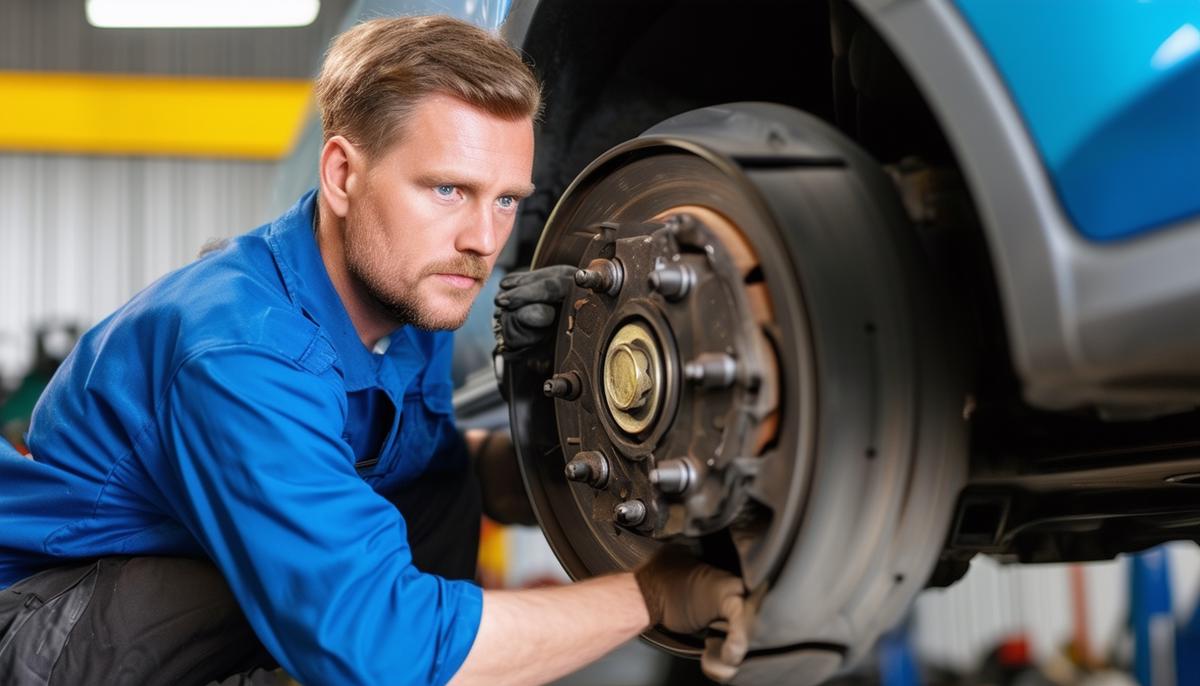The Importance of Safety Inspections
All vehicles registered in New York State require a safety inspection at a DMV-licensed inspection station once every 12 months or upon transfer of ownership. A valid inspection sticker must be displayed on the vehicle to avoid fines, parking tickets, and registration renewal issues.
Most vehicles must also pass an emissions inspection along with the safety check. The NYVIP3 page provides comprehensive details on this combined inspection requirement.
Licensed stations for safety inspections universally display a yellow and black 'Official Inspection Station' sign. Motorcycle inspection stations use a blue and orange sign instead.
The equipment items checked during a safety inspection include brakes, tires, lights, seatbelts, glass, tint, steering, and more. For vehicles bought from non-dealers, New York grants a 10-day inspection extension from the date of registration. Out-of-state registrations with valid inspection stickers remain effective until they expire or one year post the registration date, whichever is first.
Common Inspection Components
During a vehicle safety inspection, several key components are examined to ensure the vehicle meets safety standards. This thorough check covers critical systems and elements that, if faulty, could compromise both the safety of the vehicle occupants and others on the road.
Brakes are one of the most vital components checked during a safety inspection. Effective brakes are essential for stopping a vehicle promptly and safely, preventing accidents. The inspection includes examining the brake pads, rotors, and hydraulic system for wear and leaks. Emergency brakes are also tested to ensure they function correctly.
Tires are another crucial aspect of the inspection. Inspectors check for sufficient tread depth, signs of dry rot, bubbles, or other damages that could lead to tire failure. Proper tire maintenance ensures better traction, especially in adverse weather conditions, and prevents blowouts that could result in loss of vehicle control.
Lights such as headlights, taillights, brake lights, turn signals, and hazard lights are all examined for proper functionality. These lights are essential for visibility, helping drivers see the road ahead and be seen by other drivers. Faulty lights can lead to accidents, especially at night or in poor weather conditions, making this an area that can't be overlooked.
Mirrors, windshields, and windshield wipers are assessed to ensure clear visibility and proper operation. Functioning wipers are necessary to keep the windshield clear, maintaining visibility and safety.
Seat belts are tested for proper operation, including their ability to retract and auto-lock. Functioning seat belts are fundamental safety features that restrain occupants in case of a collision, reducing the risk of injury.
Steering and alignment are critical for vehicle control. Inspections ensure that steering components are not loose and that the vehicle's alignment is accurate. Suspension components are also checked to confirm they are in good condition, providing a smooth ride and stable handling.
Each of these components plays a significant role in vehicle safety. Regular inspections are necessary to identify and address potential issues before they lead to failures on the road, contributing to safer roads for everyone.

State-Specific Requirements
State-specific requirements for vehicle safety inspections differ significantly across the United States, highlighting varying levels of oversight and concern for road safety.
- In New York, every vehicle must undergo an annual comprehensive safety inspection covering components like brakes, tires, lights, and seatbelts, along with an emissions test for most vehicles.
- Virginia also has stringent annual safety inspections, with data from 2018 showing that 1.6 million out of 8 million inspected vehicles failed due to critical safety issues.
- North Carolina requires annual safety inspections and emissions tests in its 48 most populous counties, while other counties only require safety inspections.
- Texas also combines annual safety inspections with smog checks in larger urban areas.
- Rhode Island takes a biennial approach, requiring inspections every two years that cover both safety and emissions.
- In contrast, Ohio only mandates smog checks every two years in the Cleveland area, without safety inspections.
Some states like South Carolina, Mississippi, North Dakota, and South Dakota have no mandatory safety inspections at all. Studies have shown an increase in traffic fatalities after states like South Carolina and Florida eliminated their inspection programs.
These varying requirements underscore the diverse approaches to road safety across the U.S. While some states maintain rigorous annual checks, others rely on vehicle owners' diligence to ensure safety, leading to different outcomes in vehicle maintenance standards and road safety.
The Role of New Technologies
The evolution of automotive technologies like Advanced Driver Assistance Systems (ADAS), telematics, and connected vehicles presents opportunities and challenges for vehicle safety inspections.
ADAS features like adaptive cruise control and lane departure warnings require regular maintenance and calibration to function correctly. Safety inspections must adapt to include checks on these systems, ensuring proper operation and alignment of sensors.
Telematics provides real-time data on vehicle performance, enabling predictive maintenance strategies. During inspections, telematics data can offer insights into the vehicle's health, but data privacy concerns and ensuring proper data access and interpretation must be addressed.
Connected vehicles communicate with other vehicles, infrastructure, and the cloud, enabling features like traffic signal preemption and remote diagnostics. Inspections must ensure the integrity and security of these communication systems, as well as the ability to perform over-the-air updates.
As these technologies become more prevalent, safety inspections must evolve to incorporate checks on both hardware and software components. This requires investment in training technicians, updating inspection protocols, and developing regulatory frameworks to guide the inspection and standardization of these technologies.
By harnessing the data and capabilities of ADAS, telematics, and connected vehicles, safety inspections can transition from a compliance requirement to a proactive, data-driven approach to vehicle maintenance and safety.

Commercial Vehicle Inspections
Commercial vehicle inspections are crucial for upholding road safety and the efficiency of the transportation industry. Given the vast freight transported by commercial trucks across the United States, it is vital that these vehicles meet stringent safety criteria. Among the organizations leading these efforts is the Commercial Vehicle Safety Alliance (CVSA), renowned for its comprehensive inspection initiatives, including the notable Brake Safety Week.
The CVSA's Brake Safety Week is a dedicated period during which inspectors focus on commercial vehicle brake systems and components, ensuring they operate within acceptable safety parameters. The initiative involves widespread inspections by certified personnel, emphasizing educating drivers and enforcing compliance.
During the most recent Brake Safety Week, inspectors conducted 4,898 commercial vehicle inspections across various jurisdictions in Canada, Mexico, and the U.S. The findings were revealing:
- 4,328 vehicles, or 88%, did not have any brake-related out-of-service (OOS) violations.
- 570 vehicles had brake-related OOS violations, with 330 of these having issues with 20% of their braking systems.
This high rate of failure underscores the importance of such focused inspection initiatives. Data collected during the inspections highlights common brake violations, including worn brake lines/hoses, broken brake drums, and inoperative air warning devices. These findings are essential as they point to recurring problems that might be targeted for better preventive maintenance and industry standards.
Brake Safety Week also leverages performance-based brake testers (PBBTs) in nine U.S. jurisdictions. This advanced tool assesses the braking performance of a vehicle more comprehensively. During the event, 88 PBBT inspections were conducted, and four vehicles failed to meet the 43.5% minimum braking efficiency, resulting in their immediate removal from service.
The brake-related violations are not just a matter of regulatory compliance but are tied directly to road safety. According to the Federal Motor Carrier Safety Administration's 2023 data, brake system violations are among the top vehicle violations during roadside inspections, often leading to out-of-service orders. 1 These violations risk the safety of the driver and other road users, making the enforcement of brake inspections a priority.
The CVSA's initiatives, including the enforcement and educational efforts during Brake Safety Week, are designed to foster a culture of compliance and safety. Educational materials and direct interactions between inspectors and drivers aim to provide a comprehensive understanding of brake maintenance and its critical role in road safety.
Commercial vehicles often operate under harsh conditions, accumulating thousands of miles annually. Regular, thorough inspections ensure that these workhorses remain roadworthy, minimizing the risk of brake failures that could lead to accidents. By focusing on core safety components and adhering to strict inspection regimes, the CVSA's initiatives play a pivotal role in enhancing public safety and maintaining the integrity of commercial transportation.
The collected data helps shape future regulations, identify common defect trends, and underscore the ongoing needs for industry-wide educational efforts. Maintaining these rigorous inspection standards is essential for the safety and efficiency of the transportation sector, ensuring that both goods and drivers reach their destinations safely.
Leave a Reply